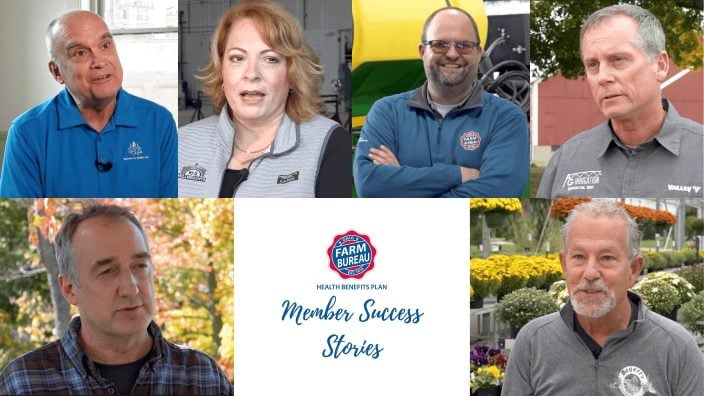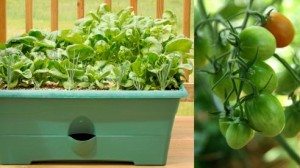Farmer’s Guide to Trucking Regulations available to Ohio Farm Bureau members
The guide includes a farm driver checklist, overview of state and federal regulations and exemptions, CDL qualifications and more.
Read More
Don’t let limited yard space keep you from growing vegetables-as long as there is at least five hours of sunshine available in your chosen spot, be it a patio, doorstep or windowsill, there is no reason why you can’t enjoy your own harvest. With the right container, and a little bit of time devoted to watering and fertilizing, wonderful, homegrown vegetables can grace your dining room table this season. Containers are also great for gardeners who are unable to bend down to the ground; a container raises the plant by at least a foot, depending on its height, enabling someone to sit or stand to tend to the plant and its yield.
There are some tips and tricks to keep in mind. Many vegetables need more soil than you would think. For instance, a single tomato needs at least 5 gallons of soil, which is about a 12-inch pot, but a bushel basket is even better, as it holds about 8 ½ gallons of soil, approximately the equivalent of a 15-inch pot. Containers need to be large to provide not only a space for root growth but also to allow for more water storage in the soil. Keeping the soil at a relatively constant moisture level will help with production. The container needs to have holes in the bottom allowing for excess water to drain (as we know, wet “feet” aren’t any fun). “Soil-less” potting mix works best in containers. These mixes are lightweight with adequate, even water retention, allowing water to drain rather quickly and leaving plenty of room for air and root growth.
Watering is the most important part of container gardening. Keeping the soil evenly moist promotes good plant health and production. The type of plants you use, the size of the container, the amount of soil, and weather conditions will determine how much and when you’ll need to water, possibly as often as every day. Always finger check the soil to make sure it needs water.
The demand for plant breeders to develop plants that work great in containers continues to grow and the availability of compact plants with good yields is increasing.
The following are some plant suggestions and corresponding container sizes for your gardens.
As always, read the plant tag or seed package. This will tell you how big a mature plant will become, determining if it is container-worthy by making sure the container and the space will allow it to grow correctly. Herbs are suited to containers-even wild and invasive mint can be controlled in a container. Lavender and rosemary like warm, well-drained soil and thrive in containers. This will be one of the only times you should limit the number of plants in the container. Remember: you are growing a crop not a display, though you may never see anything more pleasing to the eye than your own colorful vegetable container garden.
Barbara Arnold is green corps coordinator at Franklin Park Conservatory.
If you enjoyed this article, consider becoming a Farm Bureau member and you’ll receive ongoing access to information about your local food community, including seasonal recipes. Membership includes a free subscription to Our Ohio magazine. Learn more about other exclusive member benefits.


The guide includes a farm driver checklist, overview of state and federal regulations and exemptions, CDL qualifications and more.
Read More


ODA will enroll 500,000 acres into the program for a two-week sign-up period, beginning April 22, 2024, through May 6, 2024. Contact local SWCD offices to apply.
Read More

Katie Share of Columbus has been named ExploreAg and Youth Development Specialist for Ohio Farm Bureau.
Read More

Mary Klopfenstein of Delphos has been named Young Ag Professional and Ag Literacy Program Specialist for Ohio Farm Bureau.
Read More

The plan has been updated to give sole proprietors access to more rate stability and a smart solution that offers potential savings on health care.
Read More

The American Farm Bureau Federation, in partnership with Farm Credit, is seeking entrepreneurs to apply online by June 15 for the 2025 Farm Bureau Ag Innovation Challenge.
Read More

Adele Flynn of Wellington has been elected treasurer of the Ohio Farm Bureau Federation and now holds the third highest elected office in Ohio’s largest and most influential farm organization.
Read More

Producers are urged to work with their veterinarian to practice enhanced biosecurity measures and review and limit cattle movements within production systems.
Read More

The changing seasons bring with them the need to thoroughly inspect pole barns for any damages that may have occurred during the winter months.
Read More

Hundreds of Ohio businesses and sole proprietors are raving about Ohio Farm Bureau’s Health Benefits plan with lower, predictable costs and easy enrollment and administration options.
Read More